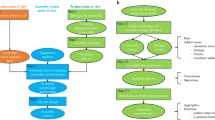Abstract
Assembly planning is a difficult problem for companies. Many disciplines such as design, planning, scheduling, and manufacturing execution need to be carefully engineered and coordinated to create successful product assembly plans. Recent research in the field of design for assembly has proposed new methodologies to design product structures in such a way that their assembly is easier. However, present assembly planning approaches lack the engineering tool support to capture all the constraints associated to assembly planning in a unified manner. This paper proposes CompositionalPlanning, a string diagram based framework for assembly planning. In the proposed framework, string diagrams and their compositional properties serve as the foundation for an engineering tool where CAD designs interact with planning and scheduling algorithms to automatically create high-quality assembly plans. These assembly plans are then executed in simulation to measure their performance and to visualize their key build characteristics. We demonstrate the versatility of this approach in the LEGO assembly domain. We developed two reference LEGO CAD models that are processed by CompositionalPlanning’s algorithmic pipeline. We compare sequential and parallel assembly plans in a Minecraft simulation and show that the time-to-build performance can be optimized by our algorithms.
All authors contributed equally to this work while at Siemens.
Access this chapter
Tax calculation will be finalised at checkout
Purchases are for personal use only
Similar content being viewed by others
Notes
- 1.
CompositionalPlanning - https://github.com/CompositionalPlanning/.
References
Building instructions (2019). www.lego.com/en-us/service/buildinginstructions
Ldraw.org standards: File format 1.0.2 (2019). www.ldraw.org/article/218.html
Minecraft Java Edition. [digital] (2019). www.minecraft.net/en-us/download
The Julia Programming Language (2020). https://julialang.org/
Aluru, K.C., Tellex, S., Oberlin, J., MacGlashan, J.: Minecraft as an experimental world for AI in robotics. In: 2015 AAAI Fall Symposium Series (2015)
Baez, J.C., Erbele, J.: Categories in control. Theory Appl. Categ. 30(24), 836–881 (2015). Available at arXiv:1405.6881
Blondel, V.D., Guillaume, J.L., Lambiotte, R., Lefebvre, E.: Fast unfolding of communities in large networks. J. Stat. Mech: Theory Exp. 2008(10), P10008 (2008)
Cheney, D., Fischer, B.: Measuring the PMI Modeling Capability in CAD Systems: Report 1 - Combined Test Case Verification. Technical report 15–997, NIST, November 2015
Coecke, B., Sadrzadeh, M., Clark, S.: Mathematical foundations for a compositional distributional model of meaning (2010). Available at arXiv:1003.4394
Cordasco, G., Rosenberg, A.L.: On scheduling series-parallel DAGs to maximize AREA. Int. J. Found. Comput. Sci. 25(05), 597–621 (2014)
De Mello, L.H., Sanderson, A.C.: And/or graph representation of assembly plans. IEEE Trans. Robot. Autom. 6(2), 188–199 (1990)
Duncan, S.C.: Minecraft, beyond construction and survival. Well Played 1(1), 1–22 (2011). Available at dl.acm.org/citation.cfm?id=2207096.2207097
Favi, C., Germani, M., Mandolini, M.: Design for manufacturing and assembly vs. design to cost: toward a multi-objective approach for decision-making strategies during conceptual design of complex products. Procedia CIRP 50, 275–280 (2016)
Fox, B., Kempf, K.: Opportunistic scheduling for robotic assembly. In: Proceedings of 1985 IEEE International Conference on Robotics and Automation, vol. 2, pp. 880–889, March 1985
Ghandi, S., Masehian, E.: Review and taxonomies of assembly and disassembly path planning problems and approaches. Comput. Aided Des. 67(C), 58–86 (2015)
Girvan, M., Newman, M.E.: Community structure in social and biological networks. Proc. Natl. Acad. Sci. 99(12), 7821–7826 (2002)
Jiménez, P.: Survey on assembly sequencing: a combinatorial and geometrical perspective. J. Intell. Manuf. 24(2), 235–250 (2013). Available at doi.org/10.1007/s10845-011-0578-5
Joyal, A., Street, R.: The geometry of tensor calculus, i. Adv. Math. 88(1), 55–112 (1991). Available at www.sciencedirect.com/000187089190003P
Kretschmer, R., Pfouga, A., Rulhoff, S., Stjepandi, J.: Knowledge-based design for assembly in agile manufacturing by using data mining methods. Adv. Eng. Inform. 33(C), 285–299 (2017)
Master, J.: Generalized petri nets (2019). Available at arXiv:1904.09091
Michniewicz, J., Reinhart, G., Boschert, S.: Cad-based automated assembly planning for variable products in modular production systems. Procedia CIRP 44, 44–49 (2016). 6th CIRP Conference on Assembly Technologies and Systems (CATS)
Mitchell, M.: Creating minimal vertex series-parallel graphs from directed acyclic graphs. In: Proceedings of the 2004 Australasian Symposium on Information Visualisation, pp. 133–139 (2004)
Pintzos, G., Triantafyllou, C., Papakostas, N., Mourtzis, D., Chryssolouris, G.: Assembly precedence diagram generation through assembly tiers determination. Int. J. Comput. Integr. Manuf. 29, 1045–1057 (2016)
Rosell, J.: Assembly and task planning using petri nets: a survey. Proc. Inst. Mech. Eng. Part B J. Eng. Manuf. 218(8), 987–994 (2004)
Rosenberg, A.L.: Scheduling DAGs opportunistically: the dream and the reality circa 2016. In: Dutot, P.-F., Trystram, D. (eds.) Euro-Par 2016. LNCS, vol. 9833, pp. 22–33. Springer, Cham (2016). https://doi.org/10.1007/978-3-319-43659-3_2
Sassone, V.: On the category of Petri net computations. In: Mosses, P.D., Nielsen, M., Schwartzbach, M.I. (eds.) CAAP 1995. LNCS, vol. 915, pp. 334–348. Springer, Heidelberg (1995). https://doi.org/10.1007/3-540-59293-8_205
Selinger, P.: A Survey of Graphical Languages for Monoidal Categories. In: Coecke, B. (ed.) New Structures for Physics. Lecture Notes in Physics, vol. 813. Springer, Heidelberg (2010). https://doi.org/10.1007/978-3-642-12821-9_4. Available at arXiv:0908.3347
Traag, V.A., Waltman, L., van Eck, N.J.: From Louvain to Leiden: guaranteeing well-connected communities. Sci. Rep. 9, 1–12 (2019)
Valdes, J., Tarjan, R.E., Lawler, E.L.: The recognition of series parallel digraphs. SIAM J. Comput. 11(2), 298–313 (1982)
Zha, X., Lim, S., Fok, S.: Integrated intelligent design and assembly planning: a survey. Int. J. Adv. Manuf. Technol. 14(9), 664–685 (1998)
Author information
Authors and Affiliations
Corresponding author
Editor information
Editors and Affiliations
Rights and permissions
Copyright information
© 2020 Springer Nature Switzerland AG
About this paper
Cite this paper
Master, J., Patterson, E., Yousfi, S., Canedo, A. (2020). String Diagrams for Assembly Planning. In: Pietarinen, AV., Chapman, P., Bosveld-de Smet, L., Giardino, V., Corter, J., Linker, S. (eds) Diagrammatic Representation and Inference. Diagrams 2020. Lecture Notes in Computer Science(), vol 12169. Springer, Cham. https://doi.org/10.1007/978-3-030-54249-8_14
Download citation
DOI: https://doi.org/10.1007/978-3-030-54249-8_14
Published:
Publisher Name: Springer, Cham
Print ISBN: 978-3-030-54248-1
Online ISBN: 978-3-030-54249-8
eBook Packages: Computer ScienceComputer Science (R0)




